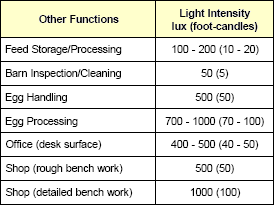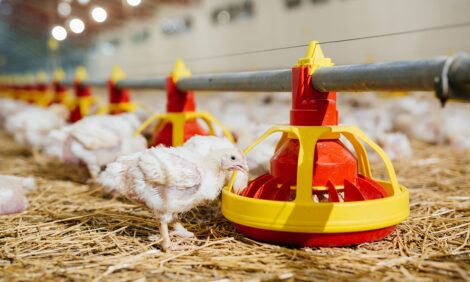



Lighting for Poultry Housing
By W.Winchell, Agricultural Engineer, The Canada Plan Service. Light levels (intensity or illuminance) and the duration of light (photo period) are important factors in poultry production. Intensity has an effect on cannibalism and aggression, along with feed and water intake, while photo period influences reproductive and egg production cycles, total feed intake, and growth rate.
Lighting for Poultry Housing - By W.Winchell, Agricultural Engineer, The Canada Plan Service. Light levels (intensity or illuminance) and the duration of
light (photo period) are important factors in poultry
production. Intensity has an effect on cannibalism and
aggression, along with feed and water intake, while photo
period influences reproductive and egg production cycles,
total feed intake, and growth rate.
Light intensity at the working plane (bird level, egg
collection table, work-bench level, etc.,) is measured in
lux or foot-candles (10 lux equals about one foot-candle).
Typical light levels found in broiler and layer operations are about 10 to 20 lux (1 to 2 foot-candles), while a bright sunny day in mid-summer is about 80,000 lux (8,000 foot-candles). Typical light levels on the surface of an office desk might be 400 to 500 lux (40 to 50 foot-candles).
Table 6 gives some typical spacings of incandescent and fluorescent light fixtures for a typical set of poultry barn conditions.
Total light source output is measured in “lumens” (lumens per area is equal to foot-candles or lux). The efficiency of a light source is measured in lumens per watt. Table 7 gives a comparison of light sources and their efficiencies.
Incandescent or fluorescent fixtures are the most common in poultry facilities. The other types are classified as high-intensity discharge, and although they are more efficient, they are better suited for ceiling heights over 12 feet, and in some cases have poor colour rendition.
Lights in all poultry production facilities should be dimmable in order to achieve the desired light intensity. This is usually accomplished by a manual or computerized rheostat. Another option might be to have several separate lighting circuits that can be turned on or off to achieve different light levels. The light circuitry must also be on a timer to regulate photo period.
 The Canada Plan Service prepares leaflets showing how to construct modern farm buildings, livestock housing systems, storage and equipment for Canadian agriculture. Permission is given to copy this leaflet. You may contact
the Canada Plan Service through your provincial agriculture department or on the internet at www.cps.gov.on.ca.
The Canada Plan Service prepares leaflets showing how to construct modern farm buildings, livestock housing systems, storage and equipment for Canadian agriculture. Permission is given to copy this leaflet. You may contact
the Canada Plan Service through your provincial agriculture department or on the internet at www.cps.gov.on.ca.
Typical light levels found in broiler and layer operations are about 10 to 20 lux (1 to 2 foot-candles), while a bright sunny day in mid-summer is about 80,000 lux (8,000 foot-candles). Typical light levels on the surface of an office desk might be 400 to 500 lux (40 to 50 foot-candles).
Variation of the photo period is used to stimulate egg
production in pullet flocks for both breeding and
commercial layers. In broilers (chickens and turkeys),
several different lighting programs are being studied to
help improve skeletal development through feed intake.
All lighting programs that use more hours of darkness
than the hours of darkness during natural day length
require light traps on fans and air inlets.
The following tables provide some of the most common
lighting programs for different types of poultry operations.
Table 1 Lighting Programs for Commercial Layers

Table 2 Lighting Programs for Breeders (broiler and commercial layers)

Table 3 Lighting Programs for Broilers/Roasters

Table 4 Lighting Programs for Turkeys


Table 2 Lighting Programs for Breeders (broiler and commercial layers)

Table 3 Lighting Programs for Broilers/Roasters

Table 4 Lighting Programs for Turkeys

Table 5 Lighting Programs for Other Functions

Table 6 Fixture Spacings

Table 7 Light Sources and Their Efficiencies

Light intensity is affected by many variables: lamp type
(i.e., incandescent versus fluorescent, versus high
pressure sodium, versus metal halide, versus low
pressure sodium, etc.); reflectance of the floor, walls,
ceiling; height of the lamp fixture above the working
plane; dirty conditions, and maintenance schedule.

Table 6 Fixture Spacings

Table 7 Light Sources and Their Efficiencies

Table 6 gives some typical spacings of incandescent and fluorescent light fixtures for a typical set of poultry barn conditions.
Total light source output is measured in “lumens” (lumens per area is equal to foot-candles or lux). The efficiency of a light source is measured in lumens per watt. Table 7 gives a comparison of light sources and their efficiencies.
Incandescent or fluorescent fixtures are the most common in poultry facilities. The other types are classified as high-intensity discharge, and although they are more efficient, they are better suited for ceiling heights over 12 feet, and in some cases have poor colour rendition.
Lights in all poultry production facilities should be dimmable in order to achieve the desired light intensity. This is usually accomplished by a manual or computerized rheostat. Another option might be to have several separate lighting circuits that can be turned on or off to achieve different light levels. The light circuitry must also be on a timer to regulate photo period.
 The Canada Plan Service prepares leaflets showing how to construct modern farm buildings, livestock housing systems, storage and equipment for Canadian agriculture. Permission is given to copy this leaflet. You may contact
the Canada Plan Service through your provincial agriculture department or on the internet at www.cps.gov.on.ca.
The Canada Plan Service prepares leaflets showing how to construct modern farm buildings, livestock housing systems, storage and equipment for Canadian agriculture. Permission is given to copy this leaflet. You may contact
the Canada Plan Service through your provincial agriculture department or on the internet at www.cps.gov.on.ca.








